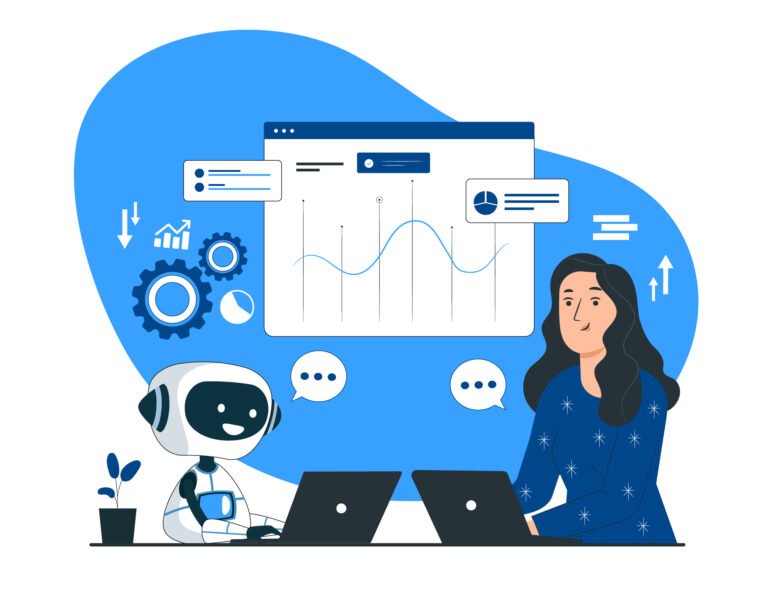Artificial Intelligence (AI) Chatbot Development for Customer Service
Artificial Intelligence (AI) chatbots are becoming increasingly popular among businesses worldwide. AI chatbots are computer programs designed to simulate human conversation through text or voice-based interactions. They are programmed to recognize customer queries and respond with relevant answers or solutions. AI chatbots have become a game-changer for businesses looking to enhance their customer service experience.

In this article, we will discuss the importance of AI chatbots in customer service and the process of developing AI chatbots for customer service.
Importance of AI Chatbots in Customer Service
The importance of AI chatbots in customer service cannot be overemphasized. Here are some reasons why:
24/7 Availability
One of the biggest advantages of AI chatbots is their availability. Chatbots are available 24/7, which means that customers can receive assistance at any time of the day, regardless of their location. This is particularly beneficial for businesses that operate in multiple time zones.
Cost-Effective
Another significant advantage of AI chatbots is that they are cost-effective compared to human customer service representatives. Businesses can save a lot of money by employing chatbots instead of human customer service representatives.
Efficient
AI chatbots are efficient in handling multiple customer queries at the same time. Unlike human customer service representatives who can only attend to one customer at a time, chatbots can attend to multiple customers at the same time. This not only saves time but also increases the efficiency of customer service operations.
Personalization
AI chatbots are capable of personalizing their interactions with customers based on their previous conversations, search history, and purchase history. This helps to create a more personalized experience for customers and increases their satisfaction.
Process of Developing AI Chatbots for Customer Service
Developing an AI chatbot for customer service involves the following steps:
- Defining the Purpose and Objectives The first step in developing an AI chatbot for customer service is to define the purpose and objectives of the chatbot. The purpose and objectives will determine the scope and functionality of the chatbot. For example, the chatbot may be designed to provide technical support, answer frequently asked questions, or assist with online purchases.
- Identifying the Target Audience The next step is to identify the target audience for the chatbot. The target audience will determine the tone and language used in the chatbot’s interactions. For example, if the chatbot is designed for a younger audience, the tone, and language used may be more informal and conversational.
- Designing the Chatbot The chatbot’s design includes creating a chatbot personality, designing the chatbot’s user interface, and determining the chatbot’s communication channels. The chatbot’s personality should align with the brand image and customer service goals. The user interface should be user-friendly and easy to navigate. The chatbot’s communication channels may include messaging apps, social media platforms, and email.
- Programming the Chatbot The next step is to program the chatbot. This involves developing the chatbot’s logic and algorithms, integrating the chatbot with the relevant systems, and testing the chatbot’s functionality. The chatbot’s logic and algorithms should be designed to understand and respond to customer queries effectively.
- Training the Chatbot The chatbot needs to be trained using natural language processing (NLP) and machine learning algorithms. This will enable the chatbot to understand and respond to customer queries effectively. The chatbot’s training data should be based on real customer interactions and should be updated regularly to improve the chatbot’s performance.
- Launching and Monitoring the Chatbot The final step is to launch the chatbot and monitor its performance. This involves collecting and analyzing data to identify areas for improvement. The chatbot’s performance should be monitored regularly, and changes should be made based on customer feedback and usage data.
Tips for Developing an Effective AI Chatbot for Customer Service
Here are some tips for developing an effective AI chatbot for customer service:
- Understand Customer Needs The chatbot’s design and functionality should be based on an understanding of the customer’s needs. This includes identifying the most common customer queries and designing the chatbot to respond to these queries effectively.
- Use Natural Language Processing (NLP) NLP is an essential aspect of developing an effective AI chatbot for customer service. The chatbot should be programmed to understand natural language queries and respond in a way that is easy for customers to understand.
- Keep the Conversation Flowing The chatbot should be designed to keep the conversation flowing smoothly. This includes designing the chatbot to ask follow-up questions and provide relevant information to the customer.
- Test the Chatbot Testing is an essential part of developing an effective AI chatbot for customer service. The chatbot should be tested in different scenarios to ensure that it can handle a variety of customer queries effectively.
- Provide Feedback Options Customers should be given the option to provide feedback on their interactions with the chatbot. This feedback can be used to improve the chatbot’s performance and make it more effective in handling customer queries.
Conclusion
- AI chatbots are a valuable tool for businesses looking to enhance their customer service experience. They offer 24/7 availability, are cost-effective, efficient in handling multiple customer queries, and can provide a personalized experience for customers. Developing an effective AI chatbot for customer service involves defining the purpose and objectives, identifying the target audience, designing the chatbot, programming the chatbot, training the chatbot, and launching and monitoring the chatbot. By following these steps and tips, businesses can create an effective AI chatbot that enhances the customer service experience and improves customer satisfaction.